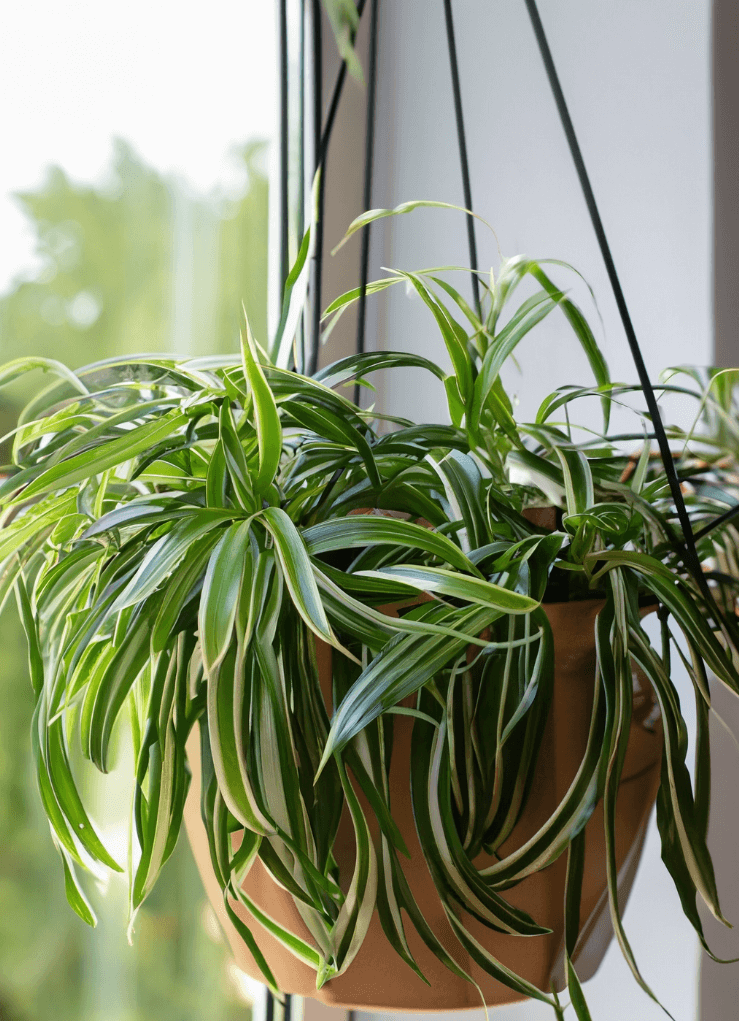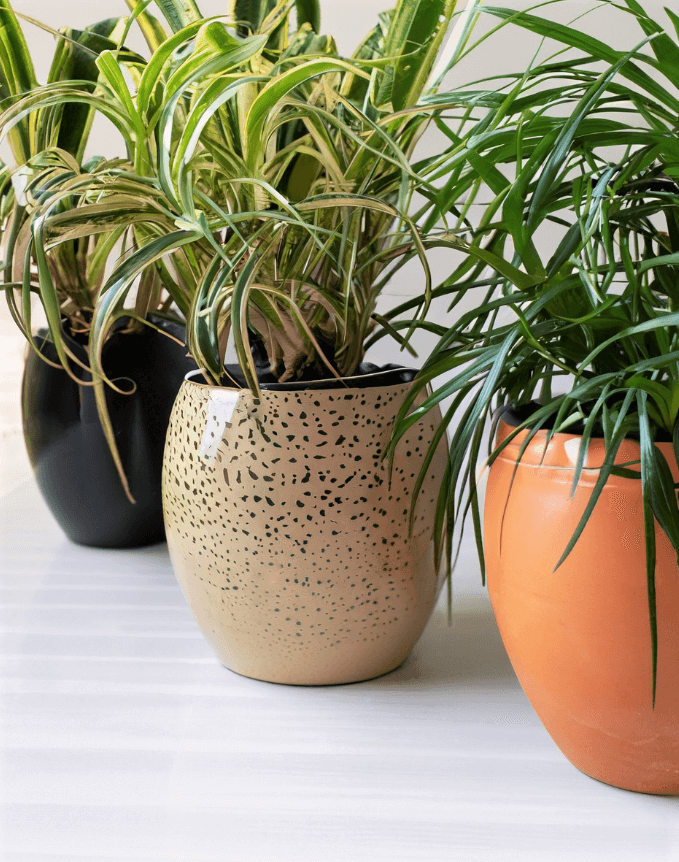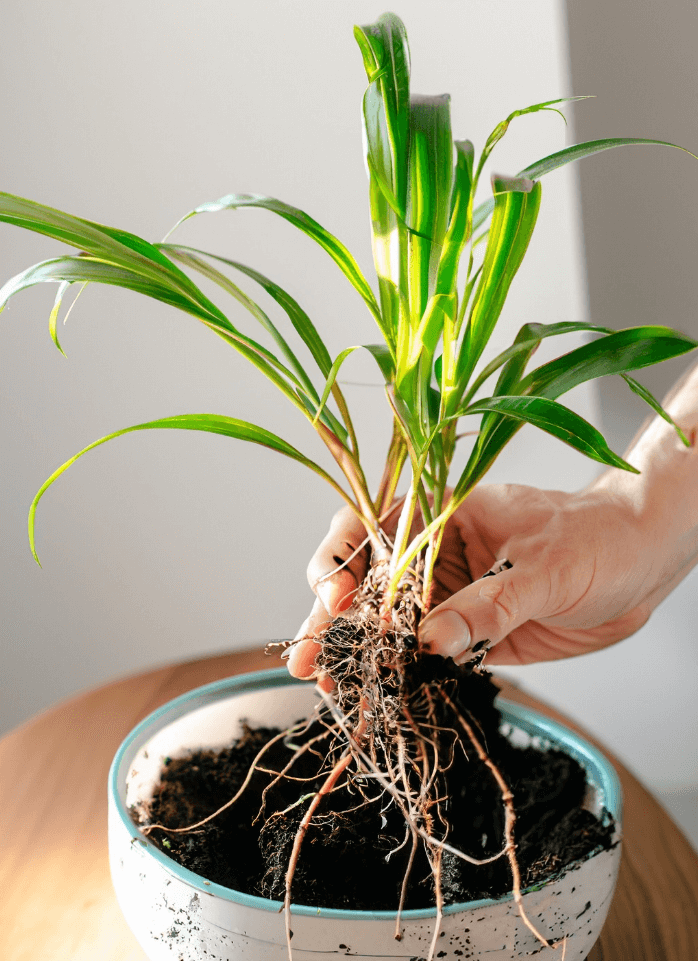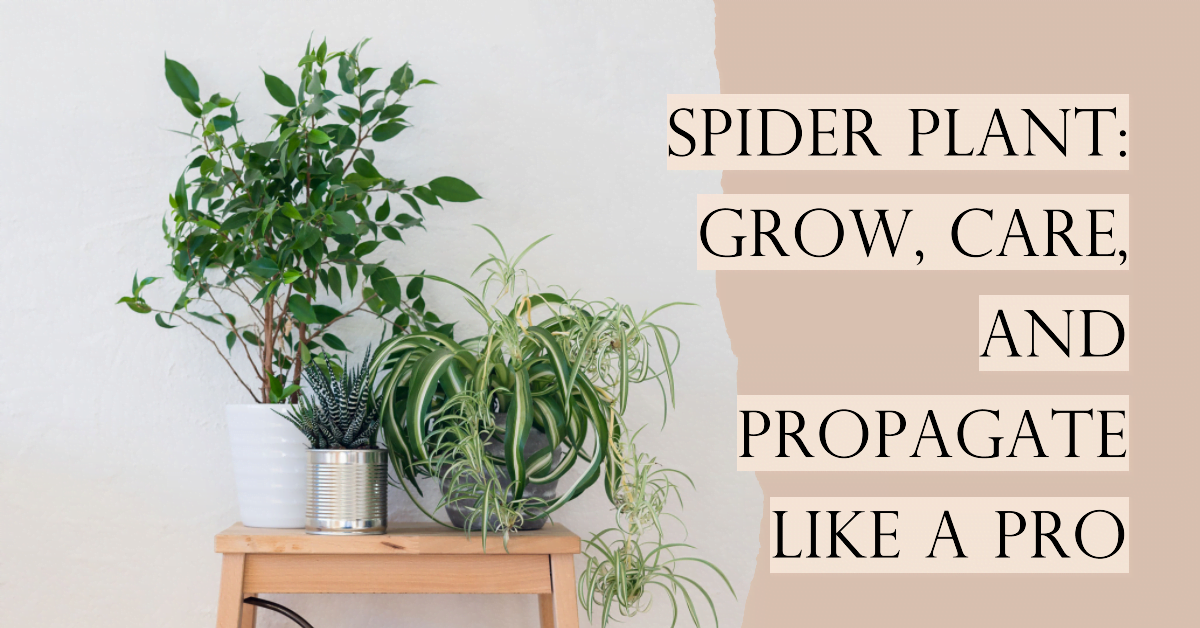The Spider Plant, one of the most popular and easy-to-care-for houseplants. Scientifically known as Chlorophytum comosum. It’s a warm-weather perennial that hails from the tropical regions, but don’t worry, this plant is incredibly adaptable and can thrive in a variety of indoor conditions and I’m thrilled to share with you why it’s such a fantastic addition to any home.
So, “Why should I consider the Spider Plant for my home decor?” Well, let me tell you, this plant is not just about aesthetics – it’s a package deal. It’s versatile, resilient, and brings a breath of fresh air – quite literally – into your home.
When adding plants to your interior design, the Spider Plant is a star player. Its cascading leaves make it an excellent choice for hanging baskets, adding a touch of greenery to your living space without taking up floor space. It’s also a great table-top plant, perfect for adding a pop of color to your office desk, bookshelf, or coffee table.

But the Spider Plant’s appeal goes beyond its good looks. This plant is also known for its air-purifying qualities. It’s one of the few houseplants recognized by NASA for its ability to remove indoor pollutants such as formaldehyde from the air. So, by bringing a Spider Plant into your home, you’re not just enhancing your decor, you’re also improving your indoor air quality.
In the coming sections, we’ll go deeper into understanding this wonderful plant, its care, propagation, and how to seamlessly incorporate it into your interior design. Whether you’re a seasoned Horticulturists or a newbie, I promise you, the Spider Plant is a joy to grow and a fantastic addition to any home decor.
Understanding the Spider Plant
The Spider Plant is a perennial plant native to tropical and southern Africa. It’s a fascinating plant with a unique growth pattern. The plant grows in rosettes, with slender, arching leaves that can stretch from around 12 to 18 inches long. The leaves are either solid green or variegated with white, adding a touch of elegance to the plant’s appearance.
One of the most captivating aspects of the Spider Plant is its ability to produce ‘plantlets’. Mature plants regularly send out long stems that bear small, star-shaped flowers. Once these flowers are fertilized, they form small fruits. After the flowers fall off, tiny plantlets form in their place. These plantlets eventually grow their own roots and can be snipped off to create new potted plants. This unique characteristic has earned it the name ‘Spider Plant’, as the plantlets dangling from the mother plant resemble spiders on a web.

There are several varieties of Spider Plants, each with its own unique charm. Here are a few:
- Chlorophytum comosum ‘Variegatum’: This variety has leaf margins of cream or white with a dark green stripe down the middle. Its long stems are green.
- Chlorophytum comosum ‘Vittatum’: This plant’s leaves have a center white stripe surrounded by medium green margins. Its long stems are white.
- Chlorophytum comosum ‘Bonnie’: This variety is more compact than the main species plant and has loosely curled leaves with green margins and a cream center stripe. It produces yellow flowers.
The Spider Plant is moderately fast-growing and can be planted at any time as long as it’s not exposed to frost. It’s often grown in containers as hanging plants due to the cascading nature of their foliage and their long stems with plantlets. They also look great when grown atop columns or placed on a shelf or table.
Caring for Your Spider Plant
Despite its exotic origins, this plant is surprisingly easy to care for, making it a perfect choice for both seasoned horticulturists and beginners.
Light: Spider Plants are quite adaptable when it comes to light conditions. They prefer bright, indirect sunlight. Direct sunlight can scorch the leaves, so if you have a bright window, consider using a sheer curtain to filter the light. If you’re placing them in a room with less natural light, don’t worry – they can tolerate lower light conditions, although their growth might not be as robust.
Soil: Spider Plants aren’t picky about their soil. They can grow in a variety of soil types, but they favor loose, well-draining soil. A mix of potting soil and perlite works well to provide the drainage these plants need. They prefer a fairly neutral soil pH but can tolerate slightly acidic to slightly alkaline soil.
Water: When it comes to watering, these plants like their soil to be kept lightly moist but not soggy. Overwatering can cause root rot and ultimately kill the plant. A good rule of thumb is to water the plant thoroughly, then allow the top inch of soil to dry out before watering again. These plants are sensitive to fluoride and chlorine in tap water, which can cause the leaf tips to brown. So, if possible, use rainwater or distilled water for watering your Spider Plant.
Temperature and Humidity: Spider Plants thrive in warm, humid conditions. They don’t like temperatures below 50 degrees Fahrenheit, so it’s best to keep them in a spot away from drafts and air-conditioning vents. If the humidity in your home is low, consider placing the plant on a tray filled with pebbles and a bit of water to increase the humidity around it.

Now, let’s talk about some common mistakes in Spider Plant care and how to avoid them:
- Overwatering: This is perhaps the most common mistake. Remember, Spider Plants prefer their soil to be moist but not waterlogged. Overwatering can lead to root rot.
- Too much direct sunlight: While Spider Plants love bright light, too much direct sunlight can scorch their leaves. Always aim for bright, indirect light.
- Ignoring brown leaf tips: If you notice the tips of your plant’s leaves turning brown, it could be a sign of fluoride or chlorine in the water, or a high salt concentration in the soil. Switch to distilled or rainwater, and if the problem persists, consider repotting the plant with fresh soil.
To maintain a healthy Spider Plant, make sure to regularly check for signs of pests or disease, and remove any dead or browning leaves as they appear. Regularly rotating your Spider Plant will ensure it gets even light exposure, promoting balanced growth.
The Art of Spider Plant Propagation
This is one of the most exciting aspects of owning a Spider Plant – they’re incredibly easy to propagate, and before you know it, you’ll have baby Spider Plants to share with friends or spread around your home!
Step-by-Step Guide on Propagating Spider Plants:
- Identify a Plantlet: Look for a plantlet that has begun to develop roots. These are the small, spider-like offshoots that grow from the mother plant.
- Cut the Plantlet: Using a sharp pair of scissors or pruners, carefully cut the plantlet from the stem, ensuring you don’t damage the roots.
- Prepare a Pot: Fill a small pot with a well-draining potting mix. A mix of regular potting soil and perlite works well.
- Plant the Plantlet: Make a small hole in the center of the pot, place the plantlet in the hole, and gently cover the roots with soil. Make sure the leaves are above the soil surface.
- Water and Wait: Water the newly potted plantlet and place it in a warm spot with bright, indirect light. Keep the soil lightly moist but not soggy.
In a few weeks, your plantlet should begin to establish itself and show new growth. Congratulations, you’ve propagated a Spider Plant!

Tips for Successful Propagation:
- Choose Healthy Plantlets: For the best chance of success, choose plantlets that are healthy and have begun to develop roots.
- Don’t Overwater: Just like mature Spider Plants, plantlets don’t like to sit in soggy soil. Keep the soil lightly moist but ensure it has good drainage to prevent waterlogging.
- Provide Adequate Light: Place your newly potted plantlet in a spot with bright, indirect light to encourage healthy growth.
Common Issues During Propagation and How to Solve Them:
- Plantlet Wilting or Browning: This could be a sign of overwatering or under-watering. Check the moisture level of the soil and adjust your watering accordingly.
- No New Growth: If your plantlet isn’t showing any new growth after a few weeks, it might not be getting enough light. Try moving it to a brighter location.
- Root Rot: If the plantlet’s roots look brown and mushy, it might be suffering from root rot due to overwatering or poor drainage. If this happens, you may need to start over with a new plantlet and ensure the potting mix has good drainage.
Remember, patience is key when propagating plants. Give your Spider Plant time to adjust to its new environment and start growing.
Spider Plant and Your Home
How to incorporate Spider Plants into your home and why they make such a fantastic addition to any living space!
Incorporating Spider Plants into Your Interior Design:
Spider Plants are incredibly versatile when it comes to interior design. Their lush, arching leaves and cascading growth habit make them a perfect choice for hanging baskets. Imagine a beautifully grown Spider Plant hanging by your window, its leaves gently swaying as the breeze comes in. It’s a sight that can add a touch of tranquility to any room.
But hanging baskets aren’t the only way to display Spider Plants. They also make excellent tabletop plants. Place one on your coffee table or bookshelf, or even on your office desk. The pop of green can add life to any space and even boost your mood while you work.
Spider Plants can also be used in larger floor pots, especially if you have a plant that’s grown quite large. Positioned next to a couch or under a window, a large Spider Plant can become a stunning focal point in your room.

Benefits of Having Spider Plants in Your Home:
Beyond their aesthetic appeal, Spider Plants offer several benefits. They’re known for their air-purifying abilities. According to NASA’s Clean Air Study, Spider Plants can remove pollutants such as formaldehyde and xylene from the air. So, by having a Spider Plant in your home, you’re not just enhancing your decor, you’re also improving your indoor air quality.
Spider Plants are also known to be non-toxic to pets. So, if you have furry friends at home, you can rest easy knowing that your Spider Plant won’t harm them if they decide to take a nibble.
Tips for Positioning Spider Plants for Optimal Growth and Aesthetics:
- Light: Position your Spider Plant in a spot with bright, indirect light. Too much direct sunlight can scorch the leaves, while too little light can stunt growth.
- Humidity: Spider Plants love humidity. If your home is dry, consider placing your Spider Plant in a bathroom or kitchen where humidity tends to be higher. Alternatively, you can place the plant on a tray filled with pebbles and a bit of water to increase the humidity around it.
- Rotation: To ensure even growth, rotate your plant’s every few weeks so all sides get equal exposure to light.
- Height: Consider the height at which you display your Spider Plant. Hanging or elevated positions allow the leaves and plantlets to cascade down beautifully.
Common Issues and Solutions
let’s discuss some common issues you might encounter with your Spider Plant and how to solve them. While Spider Plants are generally quite resilient, they can occasionally run into problems. But don’t worry, most issues are easily treatable once identified.
Common Diseases and Pests:
- Brown Leaf Tips: This is a common issue with Spider Plants and is often caused by fluoride or chlorine in tap water, or a high salt concentration in the soil. Switch to distilled or rainwater, and if the problem persists, consider repotting the plant with fresh soil.
- Root Rot: This is usually a result of overwatering or poor drainage. If you notice the plant’s roots looking brown and mushy, you might need to adjust your watering schedule and ensure the pot has good drainage.
- Pests: These plants can occasionally be affected by common houseplant pests like aphids, whiteflies, and spider mites. If you notice any signs of pests, such as discolored or sticky leaves, you might need to treat your plant.

Tips for Preventing and Treating These Issues:
- Watering: Make sure to water your Spider Plant correctly. The soil should be kept lightly moist but not soggy. Overwatering can lead to root rot.
- Light: Ensure your Spider Plant is getting the right amount of light. Too much direct sunlight can scorch the leaves, while too little light can stunt growth.
- Pest Control: If you notice pests on your Spider Plant, you can rinse the plant with water to dislodge the pests. For more serious infestations, you might need to use an insecticidal soap or a natural remedy like neem oil.
Reviving a Struggling Spider Plant:
If your Spider Plant is struggling, the first step is to identify the problem. Check the plant’s environment – is it getting the right amount of light and water? Are there any signs of pests or disease?
Once you’ve identified the issue, take the necessary steps to address it. This might involve adjusting your watering schedule, moving the plant to a brighter location, or treating for pests.
If your Spider Plant has become overly root-bound, it might need to be repotted. Choose a pot that’s slightly larger than the current one and use a well-draining potting mix.
Remember, patience is key. It might take some time for your Spider Plant to bounce back, but with the right care, it can return to its former glory.
Conclusion
We’ve explored the Spider Plant in all its glory, from its unique growth pattern and easy propagation to its versatility in home decor. This plant is a true gem in the world of houseplants, offering not just aesthetic appeal, but also a host of benefits.
Spider Plants are known for their air-purifying abilities, helping to improve the indoor air quality of your home. They’re also non-toxic to pets, making them a safe choice for households with furry friends.
In terms of interior design, Spider Plants are incredibly versatile. They can be displayed in hanging baskets, placed on tables or shelves, or even grown in large floor pots. Their lush, arching leaves add a touch of greenery to any space, and their cascading growth habit creates a stunning visual effect.
But perhaps one of the most exciting aspects of owning these Plant’s is the opportunity to propagate it. With just a little bit of care, you can grow baby Spider Plants from the plantlets produced by the mother plant. It’s a rewarding process and a great way to share the love of plants with friends and family.
FAQs
Why are the tips of my Spider Plant’s leaves turning brown?
Brown tips are often a sign of fluoride or chlorine in the water, or a high salt concentration in the soil. Try using distilled or rainwater for watering your Spider Plant. If the problem persists, consider repotting the plant with fresh soil.
Can Spider Plants grow in low light?
While Spider Plants prefer bright, indirect light, they can tolerate lower light conditions. However, their growth might not be as robust, and variegated varieties may lose some of their variegation in low light.
How often should I water my Spider Plant?
Spider Plants prefer their soil to be kept lightly moist but not soggy. A good rule of thumb is to water the plant thoroughly, then allow the top inch of soil to dry out before watering again.
Are Spider Plants safe for pets?
Yes, Spider Plants are non-toxic to both cats and dogs. However, it’s always best to discourage pets from nibbling on any houseplants, as it can still cause mild digestive upset.
How often should I repot my Spider Plant?
Spider Plants typically need to be repotted every 1-2 years. If you notice that your plant has become root-bound (i.e., the roots are taking up more than half the pot or growing out of the drainage holes), it’s time to repot.
Can I grow a Spider Plant outside?
Spider Plants can be grown outside in warm climates, but they’re primarily grown as indoor plants. They prefer temperatures above 50 degrees Fahrenheit and can be damaged by frost.
Inside Decors
Team: Inside DecorsInside Decors is your trusted source for expert interior design advice, home decor inspiration, and practical decorating solutions. Our team comprises highly skilled and experienced interior designers who are passionate about transforming spaces into beautiful, functional homes.
With a commitment to excellence and a dedication to continuous learning, our designers hold various industry certifications and regularly update their knowledge to stay ahead of the latest trends and innovations in the field. This ensures that the advice and inspiration we provide are not only current but also grounded in professional expertise.
Our content spans a wide range of topics, from interior design principles and the latest trends to practical DIY projects and budget-friendly decorating tips. Whether you’re looking to revamp a single room or redesign your entire home, Inside Decors is your go-to resource.
When you read our guides, you can trust that you’re receiving advice from industry experts who are committed to helping you create the home of your dreams. We believe that everyone deserves a beautiful, comfortable home, and we’re here to provide the knowledge and tools you need to make that a reality.
Thank you for choosing Inside Decors. We look forward to helping you transform your space into a home that truly reflects your personality and style.

